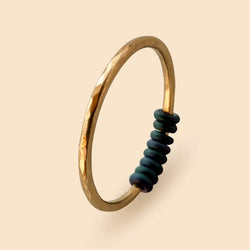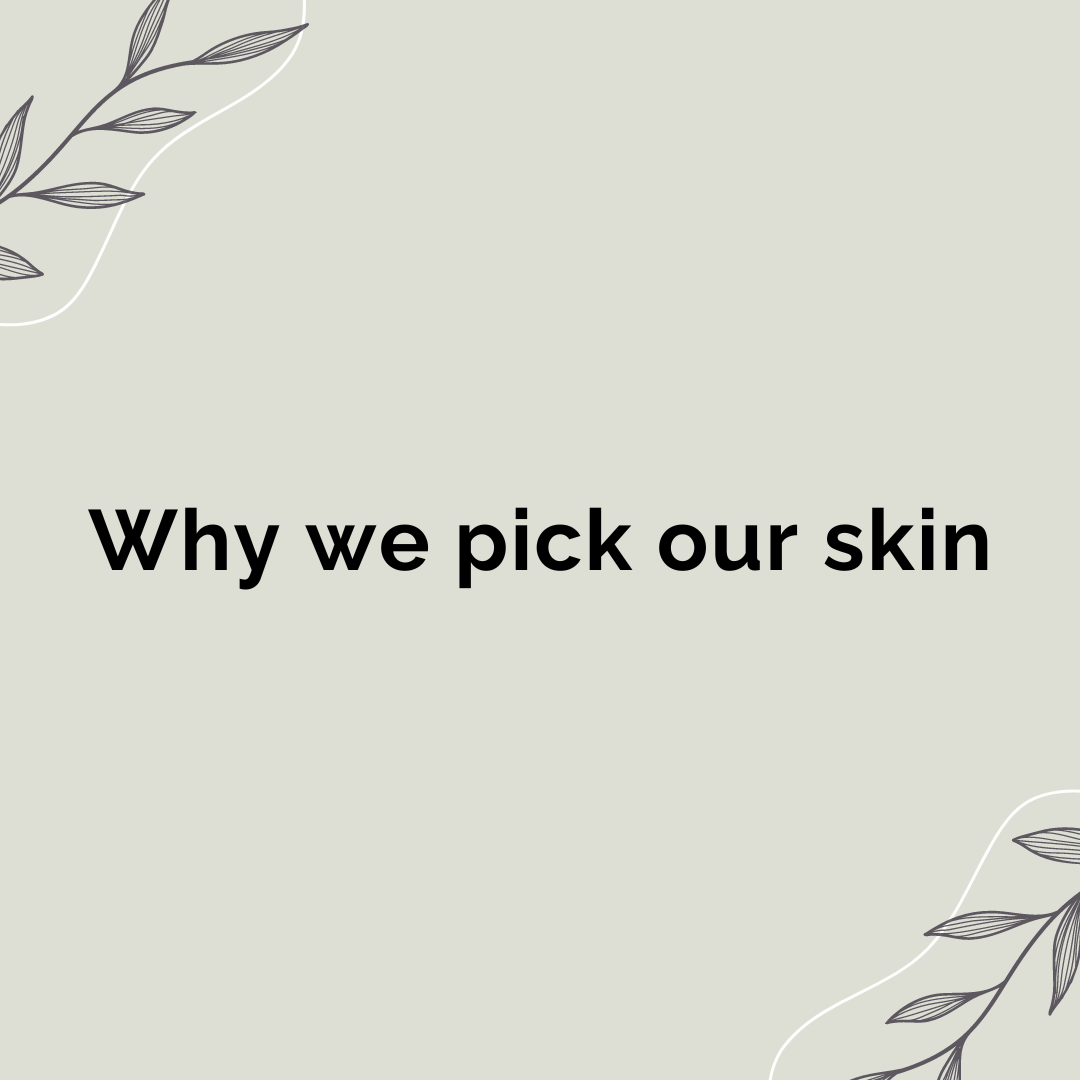What you can do
Skin picking has long been viewed as a simple habit or bad habit, without taking into account the deeper psychological and emotional dimensions. For this reason, skin picking has not yet been researched much and is still little known among medical professionals. [1]
It's important to understand that it can be very difficult to stop picking your skin completely. Our goal should therefore be to reduce the skin picking episodes and celebrate small progress towards positive change.
Think of the Fidget Ring like a yoga block in a yoga studio.
Just like a yoga block can help you with your exercises, the fidget ring can support you in changing your skin picking behavior. But just as simply owning a yoga block doesn't automatically lead to relaxation, the fidget ring alone won't magically stop your fidgeting behavior.
Fidget rings won't help you get to the bottom of your skin picking. They are not a replacement for professional help. Instead, fidget rings can serve as tools for your skill training when you're feeling restless. In the end, what helps is individual and often a combination of different methods. Fidget rings can be one of them. You'll find out what works best for you by trying different approaches.
You can try proven methods from cognitive behavioral therapy [ 1 ] [ 2 ] [ 3 ][ 4 ] on your own if the degree of skin picking or nail biting is only mild. If skin picking is seriously affecting your life, please do not hesitate and contact a medical professional directly.
1. The more you know about skin picking, the better you can take action against it.
A deeper understanding of skin picking can help you recognize your symptoms , feel less alone, and develop more effective coping strategies. With this knowledge you can take more targeted action against the tingling.
Here are more resources to learn about skin picking:
- On www.skinpicking-trichotillomanie.de explains the psychologist Dr. Christina Gallinat, what's behind skin picking and how it is classified in psychology. Ms. Gallinat has been researching for several years on skin picking at Heidelberg University Hospital.
- Skin picking guide: Help with dermatillomania - Linda M. Mehrmann, Alexander L. Gerlach
At the Chair of Clinical Psychology and Psychotherapy at the University of Cologne, psychologist Linda Mehrmann and Professor Alexander L. Gerlach are investigating the causes of skin picking and treatment options. This book is aimed at those affected and offers all the important information about skin picking as well as instructions for self-help.
2. Observe and write down in which situations you tend to pick your skin.
Many people tend to pick their skin more often in certain situations — for example during stress, or when their hands are idle, like while reading, watching TV, or daydreaming. Other common moments include waiting, working at a desk, or social interactions. Try to observe and write down the next few days
- in which situations you struggle,
- what you are feeling at this moment, and
- what consequences the pinching has.
Through self-observation and conscious awareness, you can actively notice when you pinch in the future and remember concrete strategies to combat skin picking.
3. Learn a new movement
Various studies show the effectiveness of Habit Reversal Training (HRT) for treating undesirable behaviors such as skin picking and nail biting. [ 1 ] [ 2 ] [ 4 ]
Personally, it helped me to combine HRT with a fidget ring on my index finger. Instead of giving in to the urge to fidget, I now play with the moving beads of the fidget ring. The movable beads also provide pleasant stimulation for my fingertips. In situations where I often tend to pick my skin, such as when reading, I wear the fidget ring for prevention.
Additionally, I've found that it helps to put lotion on my hands when I feel the urge to pinch. Hands that have freshly applied cream are more difficult to pick the skin.
You can find more alternative movements here: Decoupling and Habit Replacement . Both methods were developed and tested in studies by Professor Steffen Moritz and psychologist Stella Schmotz at the University Hospital Eppendorf Hamburg (UKE).
4. Practice, practice, practice
Try different techniques and choose one that feels easiest for you. Practice this movement regularly, even if it seems difficult at first. Remember, it takes time to change ingrained habits. Hang in there and be patient with yourself 💜
Current study situation
Unfortunately, there are still very few studies on the effective treatment of skin picking that were carried out in a large test group and also examined the long-term effects. However, studies in small test groups provide information about the possible effectiveness of various treatment procedures as well as long-term consequences. However, there remains a need to study larger test groups and conduct further long-term studies to confirm the effectiveness and sustainability of these treatments. To date, there are only studies on the effectiveness of cognitive-behavioral therapeutic interventions. [ 1 ] Additionally, relaxation techniques such as progressive muscle relaxation according to Jacobsen or autogenic training can be helpful in coping with stress. Moreover, developing strategies for emotional regulation can also aid in better managing stress and problems. [5]
There are currently no studies that exclusively address the use of fidget rings. This could be because fidget rings are still relatively new on the market.
Get supported through a psychotherapy
You can go through this process with the support of a psychotherapist who is familiar with skin picking. At https://www.skinpicking-trichotillomanie.de/therapie/ , psychologist Dr. Christina Gallinat explains which forms of therapy are suitable for skin picking in order to receive professional support.
Sources
[1] Mehrmann, LM, Gerlach, AL & Hunger, A. (2017). Dermatillomania (skin picking disorder): diagnosis, explanation and treatment. Current Dermatology , 43 (11), 477–491. https://doi.org/10.1055/s-0043-120953 (Accessed on July 12, 2024)
[2] Moritz, S., Fricke, S., Treszl, A. & Wittekind, CE (2012). Do it yourself! Evaluation of self-help habit reversal training versus decoupling in pathological skin picking: A pilot study. Journal Of Obsessive-Compulsive And Related Disorders , 1 (1), 41–47. https://doi.org/10.1016/j.jocrd.2011.11.001 (Accessed on July 12, 2024)
[3] Schuck K, Keijsers GP, Rinck M. The effects of brief cognitive-behavior therapy for pathological skin picking: A randomized comparison to wait-list control. Behav Res Ther. 2011 Jan;49(1):11-7. doi: 10.1016/j.brat.2010.09.005 . Epub 2010 Sep 22. PMID: 20934685. (Accessed on July 12, 2024)
[4] Teng EJ, Woods DW, Twohig MP. Habit reversal as a treatment for chronic skin picking: a pilot investigation. Behavior Modif. 2006 Jul;30(4):411-22. doi: 10.1177/0145445504265707 . PMID: 16723422. (Accessed on July 12, 2024)
[5] Paraskevi Mavrogiorgou, Armin Bader, Eggert Stockfleth, Georg Juckel (2015). "Obsessive-Compulsive Disorders in Dermatology." Journal of the German Society of Dermatology (JDDG). https://doi.org/10.1111/ddg.20_12781. (Accessed on July 12, 2024)
Let customers speak for us
from 108 reviewsHabe meinen Ring jetzt seit ein paar Wochen und bin super happy damit. Er ist auch optisch einfach was besonderes.
Ich nutze vor allem das Drehen der großen Mondkugel häufig im Alltag.
Lieferung ging auch super schnell und der Ring war sehr liebevoll verpackt.
Überlege mir schon mir zu Weihnachten noch ein zweites Modell zu wünschen.

Der Fidget Ring ist sehr filigran und wahnsinnig schön. Ich habe ihn mit durchsichtigen Perlen bestellt, worin sich das Licht fängt und die Perlen super schön schimmern. Trage die Perlen daher seitlich und gerne auch vorne am Ring. Mit der schönste Ring, den ich besitze und das sogar mit Funktion 😍 Vielen lieben Dank, auch für die tolle Beratung im Vorfeld, den schnellen Versand und die liebevolle Verpackung 🤗

Die Lieferung (in die Schweiz) klappte problemlos und schnell. Der Ring ist sehr schön, angenehm zu tragen und erfüllt den Zweck. Ich hatte schon andere Fidget Ringe, die aber nicht ganz passten, die Perlen unförmig waren oder sonst unangenehm. Das ist bei diesem Ring ganz und gar nicht der Fall.

Ich nutze den Ring, um mich in Angst- und Anspannungssituationen zu regulieren und bin sehr begeistert! Er passt perfekt und ist nun zu meinem ständigen Begleiter geworden.

Der bestellte Ring ist schnell und gut bei mir angekommen. Die Verarbeitung ist klasse. Dies ist mein zweiter Ring, manchmal trage ich beide. Die Ringe helfen mir sehr gut, wenn es mir mal nicht gut geht.

Ich habe den Anden Fidget Ring in einer Sondergröße und mit weißen Perlen bestellt. Meine Anfrage wegen der Sondergröße und den weißen Perlen wurde sofort beantwortet und war gar kein Problem. Der Ring sieht schön aus und hält seit einigen Wochen dem Praxistest stand. Auf jeden Fall empfehlenswert! :)

Ich bin schwer begeistert. Ich habe schon 2 Ringe und sie sind wunderschön, filigran und angenehm zu tragen. Bei Fragen ist der Kontakt supernett, schnell und unkompliziert. Alles kam so liebevoll verpackt bei mir an.
Und noch wichtiger: Die Ringe helfen mir wirklich sehr, meine immer nervösen Finger zu beschäftigen. Ich trage ihn von aufstehen bis zum schlafen gehen.
Danke! <3

Ich habe mich schon beim Anschauen in die Ringe verliebt und wollte deshalb gleich zwei davon haben. Die Ringe waren sehr liebevoll verpackt und ich finde beide einfach wunderschön. Sie helfen mir bei innerer Unruhe, Anspannung und Ängsten. Ich habe mich gleich an die Ringe gewöhnt und bin sehr glücklich damit.

Wow! Der Ring ist so sauber verarbeitet. Filigran, aber doch ein Hingucker. Und vor allem helfen mir die Perlen im Alltag bei mir zu bleiben und wenn ich überreizt bin, Momente der Ruhe zu nehmen. Ich bin 100% zufrieden.

Ich liebe den Ring, er hilft mir total um nicht mehr an den Nägeln zu kauen. Dabei ist er super dezent und fällt wirklich kaum auf. Er ist im Alltag nicht mehr wegzudenken. Das wird definitiv nicht die letzte Bestellung gewesen sein!

Ich habe diesen Ring für meine Tochter gekauft. Sie hat bereits ein anderes Modell und ist sehr zufrieden. Sie trägt ihn immer, wenn es im Job sehr stressig ist und schwört auf die positive Wirkung.

Der Ring erfüllt meine Erwartungen und passt wirklich wie angegossen! Danke für die liebe Kommunikation und den schnellen Versand🌞

Ich suche schon lange nach einem unauffälligen, schönen Fidget Toy und dieser Ring ist einfach perfekt! Wenn man dazu noch ein kleines unabhängiges Ein-Frau-Unternehmen unterstützen kann, umso besser:)








